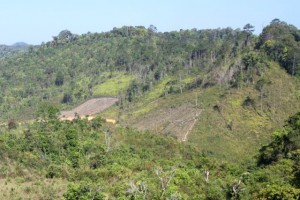Project Sekong 2014: A generation ago, before help arrived, farmers removed or destroyed ordnance themselves. Some lived, some died.

In swidden agriculture farmers cut and burn the forest and then work the land for several years before moving on to better soil. Sometimes, we search land that farmers a generation earlier risked their lives to clear of bombs and other ordnance.
On the other hand, this site has thousands of small trees the diameter of my arm and hardly a specimen bigger. Surely, this parcel was once clear-cut of vegetation, used as a garden for hill rice for five or six years, and then abandoned after the thin soil gave out. Judging from the size of these second (or third) growth trees, that cultivation probably occurred twenty or thirty years ago.
If this was once a field of upland rice, the farmers who cultivated it likely cleared it of ordnance. They’d have fretted over the danger to their wives and children and in those days no outside help was on the scene. So…with no prospect of humanitarian clearance, some brave soul would have swallowed hard, held his breath, and carried the threatening ordnance to a safer spot. This parcel is the sort of place where we find bomblets in the hollow of trees, on tree stumps and termite mounds. I wouldn’t be surprised to find ordnance in the small stream that runs past this property.
Anonymous men and women may well have given their lives to clear this land thirty years ago. Now, in a country where 80 percent of the population was born after the American bombing ended, few people in neighboring villages would remember the sacrifice.
